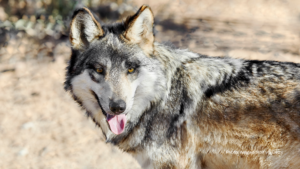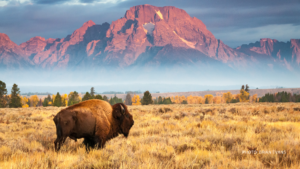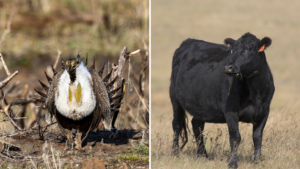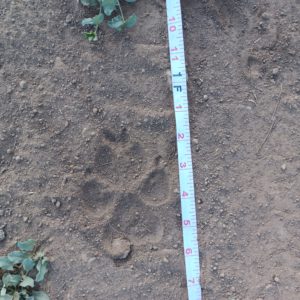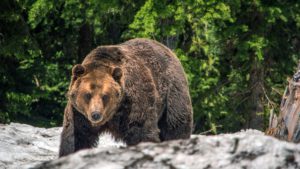For immediate release: November 2, 2023
Media contacts:
Chris Smith, WildEarth Guardians, 505-395-6177 csmith@wildearthguardians.org
Michael Robinson, Center for Biological Diversity, 575-313-7017 michaelr@biologicaldiversity.
Greta Anderson, Western Watersheds Project, 520-623-1878 greta@westernwatersheds.org
Sally Paez, New Mexico Wild, 505-350-0664 sally@nmwild.org
Regan Downey, Wolf Conservation Center, 914-763-2373 regan@nywolf.org
Mary Katherine Ray, Wildlife Chair, Rio Grande Chapter Sierra Club, 575-537-1095 mkrscrim@gmail.com
Claire Musser, Grand Canyon Wolf Recovery Project, 928-202-1325 claire@gcwolfrecovery.org
SANTA FE, NM – Asha, a lone female wolf famous for her foray into the Sangre de Cristo Mountains last year, has once again ventured into northern New Mexico. Her location in the Jemez Mountains was publicized by the New Mexico Department of Game and Fish in an apparent effort to protect her from hunters who might mistake her for a coyote. But conservation and wildlife groups are also trying to protect her from the state and federal wildlife agencies who might try to capture her and return her to the arbitrary bounds of the Mexican Wolf Experimental Population Area (MWEPA) south of Interstate 40.
“An essential part of being a wolf is roaming and dispersing to suitable, available habitat like that in the Jemez Mountains,” said Chris Smith, southwest wildlife advocate for WildEarth Guardians. “The best science indicates that lobos need to re-establish in the southern Rocky Mountains–where Asha is currently–in order to truly recover.”
Last year, the New Mexico Department of Game and Fish led the recapture effort that eventually saw Asha sent to Arizona after time in captivity. She is among a growing number of Mexican wolves, including Anubis in Arizona, who are dispersing out of the Gila Bioregion in search of more territory and mates.
“This is an incredible wolf who has shown us that she’s determined to see what’s beyond the current recovery area,” said Greta Anderson, deputy director of Western Watersheds Project. “There’s no reason to remove her. She’s never had conflict with livestock, never displayed any human habituation, and simply wants to run north. I hope we let her, and see what we can learn from her wandering.”
“Asha is doing her part to further Mexican gray wolf recovery by trying to disperse into unoccupied suitable habitat,” said Sally Paez, staff attorney for New Mexico Wild. “Asha’s journey demonstrates the urgent need to rethink wolf recovery strategies. Ideal habitats for Mexican wolves extend north of I-40, and it’s crucial to consider their need to follow natural corridors and establish sub-populations in additional areas.”
“Wolves are meant to wander, and Asha’s movements are evidence of what independent scientists have been saying for years; ideal habitat for Mexican wolves exists north of I-40,” said Regan Downey, director of education of the Wolf Conservation Center. “Asha is telling us what she needs in order to thrive, so let’s listen. Let her stay.”
“Asha keeps showing us that she wants to roam north of I-40 and find her own territory,” said Claire Musser, the Executive Director of the Grand Canyon Wolf Recovery Project, “historical range does not account for the anthropogenically caused situation that lobos find themselves in today and in the future. Their wild areas are disappearing due to climate change, habitat fragmentation, biodiversity loss, human presence, and intersected landscapes. We need to let all wolves, including Asha, adapt and find their own ways to navigate their new landscape.”
“Wolves are smart but they’re not known for reading federal regulations and shouldn’t be bound by arbitrary political boundaries,” said Michael Robinson, a senior conservation advocate at the Center for Biological Diversity. “And although wolves also don’t read peer-reviewed studies, it’s striking that Asha’s movements prove scientists’ theories correct. The southern Rockies is within loping reach of Mexican wolves and should be part of their recovery area.”
“Every time a wolf is captured, that animal risks being injured or worse,” said Mary Katherine Ray, Wildlife Chair for the Rio Grande Chapter of the Sierra Club. “Asha has not settled with any eligible single wolf south of I-40. She and wolf biologists agree that there is suitable wolf habitat north of the arbitrary I-40 boundary. We should let her be wild and find her own way.”
Lobos that disperse north of Interstate 40 are typically captured (at taxpayer expense) and taken into captivity or re-released in the Gila Bioregion. However, independent, peer reviewed science strongly suggests that recovery for Mexican wolves will entail three interconnected subpopulations of at least 200 wolves each, one in the Gila Bioregion, one in the southern Rocky Mountains, and one in the Grand Canyon Ecoregion. The current MWEPA boundary locks lobos into a tiny portion of their historic range.
Mexican gray wolves look very similar to coyotes, and the species can be hard to distinguish at a distance. In general, Mexican gray wolves are larger and have more rounded ears than coyotes. Killing a Mexican gray wolf is a federal crime, and hunters are expected to know the identity of their targets prior to shooting. More information:
https://www.wildlife.state.nm.
###

